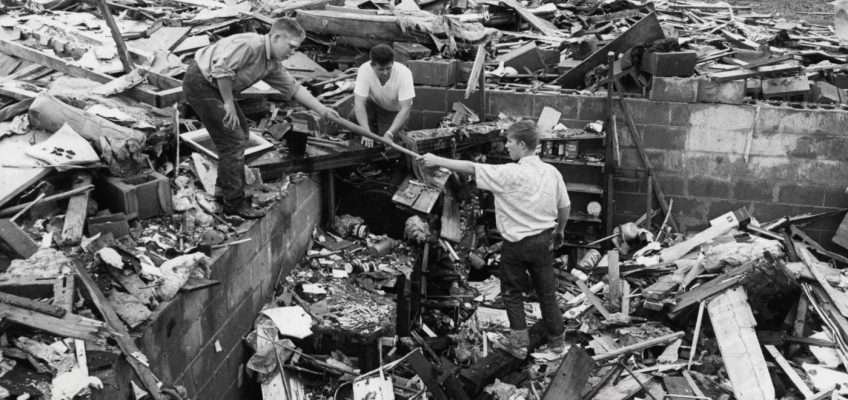The Twin Cities may have escaped the severe weather forecast by meteorologists earlier this week, but the metro wasn’t so lucky 60 years ago.
An outbreak of five tornadoes tore through the western and northern suburbs on the evening of May 6, 1965, killing 13 people and injuring hundreds more in what the St. Paul Dispatch described on its front page as a “night of terror.”
A sixth twister struck the area between Glencoe and Lester Prairie, just west of the metro.
The storm’s path of destruction stretched from Sibley County northeast to Anoka County, laying waste to entire neighborhoods in Mounds View, Fridley, Blaine and the area around Lake Minnetonka. Minneapolis and St. Paul were virtually untouched.
The most destructive storm in the metro’s recorded history, it left an estimated $51 million in damage in its wake — more than $500 million after adjusting for inflation.
The tornadoes were spun up by a line of supercell thunderstorms that rolled through the metro that evening, according to the Minnesota Department of Natural Resources. The terror lasted three hours, from the time the first twister touched down shortly after 6 p.m. until the last one dissipated about 9 p.m.
Winds exceeding 200 mph leveled houses, tore trees from the ground and tossed automobiles around like toys, the Pioneer Press and Dispatch reported. About 1,700 people were left homeless, according to the DNR.
In Mounds View, which was among the hardest hit communities, entire blocks along Lois Lane were reduced to kindling.
Area hospitals were inundated with injured people. Mercy Hospital in Coon Rapids, which received about 100 tornado victims, issued an urgent call for surgeons from across the metro. Fifty responded, working until 4 a.m. treating patients.
“The call went out and people came immediately,” assistant administrator Thomas Mattson told the Dispatch. “It goes to show that when tragedy strikes, people do care.”
The death toll likely would have been much higher if not for warnings issued by Civil Defense officials, who for the first time used air raid sirens to alert metro residents to tornadoes in the area, according to the DNR.
Related Articles
A century after it opened, St. Paul’s Ford plant is gone but not quite forgotten
Record flood of ’65 was St. Paul’s highest, but city escaped worst damage
100 years ago, ‘Gatsby’ got mixed reviews in Fitzgerald’s hometown papers
2,350 Minnesotans were sterilized under state’s 1925 eugenics law — most of them women
One of the FBI’s original 10 Most Wanted Fugitives was caught in St. Paul — by a bunch of kids


Leave a Reply